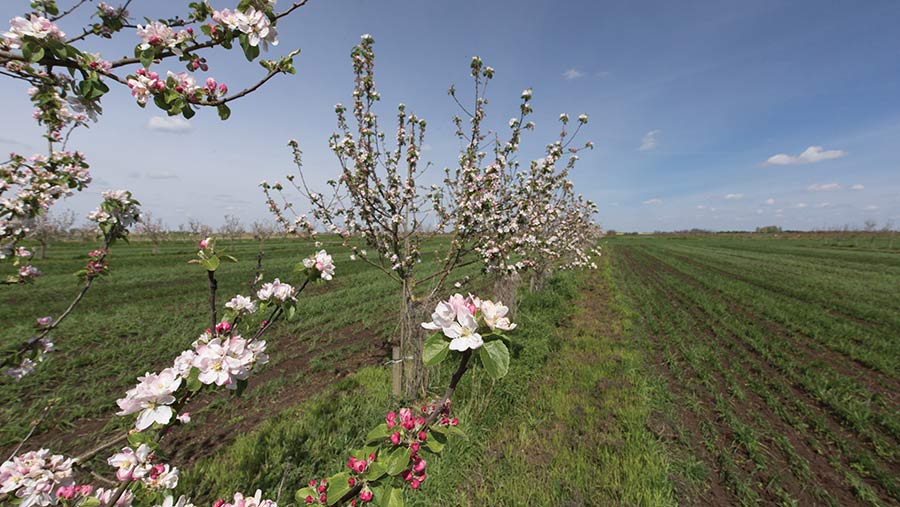Defra paves the way for more agroforestry in England
 © Tim Scrivener
© Tim Scrivener Farmers in England have been given fresh clarity on whether farmland will continue to be eligible for area payments when it is planted with trees.
The support for agroforestry – merging trees and agriculture on the same piece of land – is part of a multi-pronged approach across government to encourage tree planting.
Farmers have in the past been reluctant to integrate trees into grazing fields since the Basic Payment Scheme (BPS) was introduced, as the Rural Payments Agency (RPA) stated that grazed woodland was no longer eligible for payment.
See also: Opinion: Agroforestry – an essential part of future farming
This led to the belief that BPS is not compatible with any form of agroforestry, Defra says.
To address this, it has issued a document outlining which methods of agroforesty are compatible with BPS rules as part of a raft of measures to promote faster rates of tree planting.
It has confirmed that that land growing some types of tree is eligible for BPS, however densely grown, and set out the criteria land supporting any variety of tree need to meet to be eligible for payment.
The government tree strategy: What is it doing and why?
The government has committed to a 10-point plan for a green industrial revolution as part of its strategy to achieve net-zero carbon emissions by 2050.
Tree planting is part of the ninth leg of the plan: “Protecting our natural environment”.
Trees are seen as highly valuable as they lock up carbon, reduce the effects of flooding and benefit biodiversity.
To increase tree numbers, Defra is committing to a target to plant 30,000ha of forestry a year by 2025 and pledging to incentivise tree planting in the forthcoming Environmental Land Management (ELM) scheme.
There will also be a scheme to accelerate tree planting across England’s towns and cities and support for improving management of existing trees and woodlands.
Similar strategies are in place in other parts of the UK. The Welsh government committed in 2018 to planting 2,000ha of woodland a year from 2020, but only managed 80ha in 2019-20.
Scotland’s Climate Change Plan includes commitments to incrementally increase the annual woodland creation target from 10,000ha to 15,000ha/year by 2024-25.
Northern Ireland aims to increase planting rates to 2,000ha/year by 2025.
Steve Briggs, Cambridgeshire farmer and agroforestry consultant with Abacus Agriculture, says the update provides very welcome clarity for the fledgling sector.
“The question I get asked by farmers consistently is ‘will it affect my BPS?’,” he says.
“There has never been a clarification in black and white from Defra before.”
Farmers attitude to agroforestry has grown from ambivalence 10 years ago, to curiosity five years ago and significant interest today, he says.
Adding trees to farmland creates a more three-dimensional farmland, he explains, as they significantly increase the land’s ability to capture sunlight and their roots harvest more of the nutrients from the soil than grass or cereals are capable of.
Agroforestry can therefore increase the productive capacity of the ground and create a return on the upfront costs, providing farmers find a market for the timber or fruit and a way to fit it into the management and machinery of the existing business.
“Nitrogen use efficiency in the UK is 48% – only half is taken up by the target crop,” says Mr Briggs.
“If you were building fridges and 50% of your raw ingredient is never used, you would think it is a bit of an odd business model.
“With agroforestry you can halve that loss to 25%, as the deeper roots of the trees get a second bite of the cake.”
What does the document say?
The document sets out the land use types that will still permit BPS payments.
The following types of planting will be eligible for area payments, provided other BPS rules are complied with:
- Silvoarable (trees and crops) Trees planted at wide spacings and intercropped with a cereal or bio-energy crop.
- Silvopasture (trees and livestock) Trees combined with forage grassland and livestock production.
- Riparian forest buffer Trees planted between agricultural (land?) and watercourses such as streams, rivers and lakes to act as buffers to protect the water quality.
- Windbreak/shelterbelt Trees planted in a linear format on the edge of a field to reduce wind speed, protect crops and livestock and reduce erosion.
Significant detail is also provided on other land that will be eligible for BPS payments and that supports trees, outside of agroforestry.
More information is available on the Defra website.
Get involved with shaping the ELM agroforestry strategy
Farmers are being sought for their views on agroforestry to help inform the debate on the barriers to the practice being taken up more widely.
A two-and-a-half-year scheme has just been launched that will hold regional meetings to discuss six types of agroforestry projects – lowland silvoarable, lowland silvohorticulture, lowland silvopastoral, upland silvopastoral, woodland grazing and silvopoultry.
Three types of farmers and landowners are being sought for their views – those who are running one of these projects, those who are interested in doing it and those who have previously looked at it and decided it is not for them.
Run by consultancy firm Abacus Agriculture, the Woodland Trust, the Organic Research Council and the Soil Association, the results of the study will contribute to how support for agroforestry is integrated into Defra’s ELM scheme.
To register your interest in taking part visit the Organic Research Centre website.
